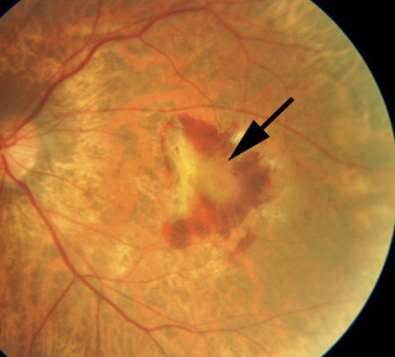 |
| Macular hemorrhage and fibrovascular membrane in a 67-year-old highly myopic female. Photo: Ophthalmology, 2010. Click image to enlarge. |
Previous studies have shown that axial length continues to grow in adults with high myopia or pathologic myopia, but risk factors for axial length changes have yet to be determined. Researchers sought to close this gap in a recent investigation.
Axial length and its annual growth rate were evaluated in 3,646 eyes from 1,877 adults in an eight-year follow-up study. The mean annual growth of axial length was 0.05mm, which accounted for 0.17% of the mean value of the entire axial length of eyes with high myopia.
Eyes with prior choroidal neovascularization and eyes in female patients had a greater annual rate of axial elongation, especially when compared with men aged 40 to 70 years, which suggests an association between female sex and more severe axial growth rate. The investigators also noted that women with high myopia are 1.51 times more likely to develop severe axial elongation than men.
Additionally, patients aged 20 to 30 years were more likely to exhibit axial length growth than patients older than 40 years, possibly due to prolonged use of computers and mobile phones.
Although prior choroidal neovascularization is considered a risk factor, the authors noted these results need to be confirmed. “A previous study reported that ocular tissues actively regulated axial elongation and that myopization was due to defects of Bruch’s membrane,” the authors explained in their study. “Thus, once Bruch’s membrane defects develop and enlarge in the foveal area, they may facilitate axial elongation.”
The study concluded that axial length changes must be further clarified, as prevention of myopia and its progression is key in reducing the prevalence of pathologic myopia and its complications in the future.
| Du R, Xie S, Igarashi-Yookoi T, et al. Continued increase of axial length and its risk factors in adults with high myopia. JAMA Ophthalmol. August 26, 2021. [Epub ahead of print]. |

